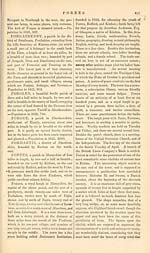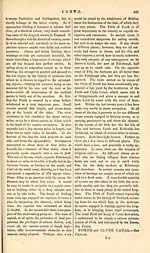Gazetteer of Scotland > Volume 1
(482) Page 448 - FOR
Download files
Complete book:
Individual page:
Thumbnail gallery: Grid view | List view

448
FORT II.
has blown during the last eight centuries. At
the western extremity of Forres, and what
seems to have been the nucleus and cause of
the town, is the castle, or rather the eminence
on which such an edifice once stood. This is
an object of some curiosity, for here Duffus, one
of the early kings of Scotland, was killed by
Donwald, governor of the castle, under circum-
stances which Shakspeare has certainly made
use of in his dramatic version of the murder of
King Duncan by Macbeth. In consequence of
this atrocious act, Forres Castle, which had
long been a royal fortress, was demolished ; but
at a period much later, that of the civil war, an-
other was founded on the same site ; of which
second erection the vaulted or lower storey
still exists. From the esplanade surround-
ing the ruin a fine view of the neighbouring
country is obtained. The river Findhorn
runs immediately behind the eminence ; at
this place a very handsome bridge was swept
away by the great flood of August ] 829. On
the height to the west of Forres, there is erect-
ed a Pharos, in honour of Nelson, to which
an excellent winding road conducts the travel-
ler from the town. As the situation is high,
and is surrounded by a level country — known
as the plain of Forres — a very fine view may
here be obtained ; and the object itself has a
good effect when seen from below or from a
distance. It is worth mentioning, as a fine in-
stance of patriotic feeling, that every indivi-
dual, man and woman, in Forres, contributed,
by labour or money, to the erection of this in-
teresting public work. The genius of Shak-
speare has immortalized the town of Forres.
It is the scene of a great part of the tragedy
of Macbeth ; and it was in a waste in the
neighbourhood that that hero, along with
Banquo, according to all the old historians,
(whom Shakspeare copied,) met the weird
sisters who gave him so many fatal promises.
The exact spot where that event is asserted by
the country people to have taken place, is
jnarked by a small clump of trees, about two
hundred yards north from the post-road be-
tween Forres and Nairn, near a toll-bar, five
miles from the former of these places, and
nearly on the confines of the two counties of
Moray and Nairn. The extensive heath still
surrounding this place is visibly worthy of the
epithet " blasted," being one of the most deso-
late and hopeless tracts of waste land anywhere
to be seen. It is called the Hard Moor, and
great part of it belongs to the ancient race of
Brodie of that Ilk. — Population in 1821, of
the town about 2G00, and, including the pa-
rish, 3540.
FORSA, an islet near Easdale, on the
west coast of Argyleshire, mouth of Loch
Linnhe, abounding in slate.
FORSE, or FORSS, a river in Caithness,
rising in the parish of Halkirk, and running
in a northerly course to the Northern Ocean,
into which it falls at a creek north of Forss
House.
FORTE VIOT, a parish in the district of
Strathearn, Perthshire, composed of three
widely detached portions, the chief of which
lies in the vale of the Earn, (that river pass .
ing through it,) betwixt Forgandenny on the
east, and Dunning on the west. Another and
small portion is in the hilly district, adjacent
to Kinross-shire ; and the third part is situat-
on the north side of the Earn, north of Dum-
barney, adjacent to the hill of Moncrieff. The
middle portion, in the vale of the Earn, is
beautifully wooded and enclosed. It is inter-
sected by the river May, which joins the Earn
nearly opposite Dupplin Castle. The village
of Forteviot on the right bank of this stream,
about two miles from its mouth, is an ancient
capital of the Pictish kingdom ; but nothing
now remains to mark a royal seat. In the
vale of the May is the seat of Invermay,
whose beauties and birches engaged the poetic
effusions of Mallet, upwards of a century ago. -
— Population in 1821,797.
FOR.TH, a distinguished Scottish river,
on the east side of Scotland, having its chief
sources in two upper branches, one of which
rises like a rill from the north side of Ben-
lomond, and flows through the north-west-
ern part of Stirlingshire in an easterly direc-
tion, under the appellation of the Water of
Duchray, till it joins the other branch above
Aberfoil. This second arises in Loch Chon,
further to the north, and after falling over a pre-
cipice, forms first .Loch Ard, and then several
smaller expansions. Being joined, the united
stream receives the name of the Avondow or
Black River, which it retains for five miles till
it reaches Gartmore, when the title of the
Forth is conferred on it. Besides receiving
accessions from various small tributaries, it re-
ceives some large streams, before reaching
Stirling, as the Goodie, the Teith, and the
Allan. Inmanyplaces it serves as theboundary
FORT II.
has blown during the last eight centuries. At
the western extremity of Forres, and what
seems to have been the nucleus and cause of
the town, is the castle, or rather the eminence
on which such an edifice once stood. This is
an object of some curiosity, for here Duffus, one
of the early kings of Scotland, was killed by
Donwald, governor of the castle, under circum-
stances which Shakspeare has certainly made
use of in his dramatic version of the murder of
King Duncan by Macbeth. In consequence of
this atrocious act, Forres Castle, which had
long been a royal fortress, was demolished ; but
at a period much later, that of the civil war, an-
other was founded on the same site ; of which
second erection the vaulted or lower storey
still exists. From the esplanade surround-
ing the ruin a fine view of the neighbouring
country is obtained. The river Findhorn
runs immediately behind the eminence ; at
this place a very handsome bridge was swept
away by the great flood of August ] 829. On
the height to the west of Forres, there is erect-
ed a Pharos, in honour of Nelson, to which
an excellent winding road conducts the travel-
ler from the town. As the situation is high,
and is surrounded by a level country — known
as the plain of Forres — a very fine view may
here be obtained ; and the object itself has a
good effect when seen from below or from a
distance. It is worth mentioning, as a fine in-
stance of patriotic feeling, that every indivi-
dual, man and woman, in Forres, contributed,
by labour or money, to the erection of this in-
teresting public work. The genius of Shak-
speare has immortalized the town of Forres.
It is the scene of a great part of the tragedy
of Macbeth ; and it was in a waste in the
neighbourhood that that hero, along with
Banquo, according to all the old historians,
(whom Shakspeare copied,) met the weird
sisters who gave him so many fatal promises.
The exact spot where that event is asserted by
the country people to have taken place, is
jnarked by a small clump of trees, about two
hundred yards north from the post-road be-
tween Forres and Nairn, near a toll-bar, five
miles from the former of these places, and
nearly on the confines of the two counties of
Moray and Nairn. The extensive heath still
surrounding this place is visibly worthy of the
epithet " blasted," being one of the most deso-
late and hopeless tracts of waste land anywhere
to be seen. It is called the Hard Moor, and
great part of it belongs to the ancient race of
Brodie of that Ilk. — Population in 1821, of
the town about 2G00, and, including the pa-
rish, 3540.
FORSA, an islet near Easdale, on the
west coast of Argyleshire, mouth of Loch
Linnhe, abounding in slate.
FORSE, or FORSS, a river in Caithness,
rising in the parish of Halkirk, and running
in a northerly course to the Northern Ocean,
into which it falls at a creek north of Forss
House.
FORTE VIOT, a parish in the district of
Strathearn, Perthshire, composed of three
widely detached portions, the chief of which
lies in the vale of the Earn, (that river pass .
ing through it,) betwixt Forgandenny on the
east, and Dunning on the west. Another and
small portion is in the hilly district, adjacent
to Kinross-shire ; and the third part is situat-
on the north side of the Earn, north of Dum-
barney, adjacent to the hill of Moncrieff. The
middle portion, in the vale of the Earn, is
beautifully wooded and enclosed. It is inter-
sected by the river May, which joins the Earn
nearly opposite Dupplin Castle. The village
of Forteviot on the right bank of this stream,
about two miles from its mouth, is an ancient
capital of the Pictish kingdom ; but nothing
now remains to mark a royal seat. In the
vale of the May is the seat of Invermay,
whose beauties and birches engaged the poetic
effusions of Mallet, upwards of a century ago. -
— Population in 1821,797.
FOR.TH, a distinguished Scottish river,
on the east side of Scotland, having its chief
sources in two upper branches, one of which
rises like a rill from the north side of Ben-
lomond, and flows through the north-west-
ern part of Stirlingshire in an easterly direc-
tion, under the appellation of the Water of
Duchray, till it joins the other branch above
Aberfoil. This second arises in Loch Chon,
further to the north, and after falling over a pre-
cipice, forms first .Loch Ard, and then several
smaller expansions. Being joined, the united
stream receives the name of the Avondow or
Black River, which it retains for five miles till
it reaches Gartmore, when the title of the
Forth is conferred on it. Besides receiving
accessions from various small tributaries, it re-
ceives some large streams, before reaching
Stirling, as the Goodie, the Teith, and the
Allan. Inmanyplaces it serves as theboundary
Set display mode to: Large image | Transcription
Images and transcriptions on this page, including medium image downloads, may be used under the Creative Commons Attribution 4.0 International Licence unless otherwise stated. ![]()
| Gazetteers of Scotland, 1803-1901 > Gazetteer of Scotland > Volume 1 > (482) Page 448 - FOR |
|---|
| Permanent URL | https://digital.nls.uk/97430146 |
|---|
| Description | Volume I: Abbey to Glenartney. |
|---|---|
| Attribution and copyright: |
|
| Description | By Robert Chambers and William Chambers. Glasgow: Blackie & Son, 1838. 2 volumes. |
|---|---|
| Shelfmark | NF.1461.g.7 |
| Additional NLS resources: | |

